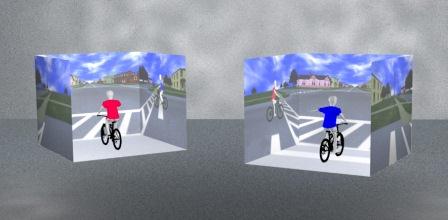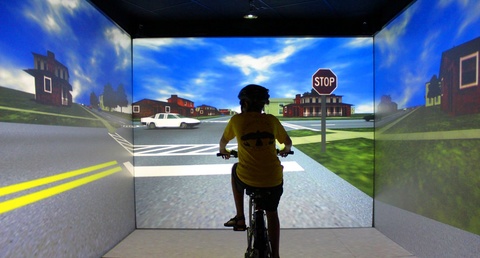Breadcrumb
Bicycling & Pedestrian Simulator Research
Overview
Our bicycling and pedestrian simulator research has two main objectives. One is to better understand the factors that put children at risk for getting hit by motor vehicles when crossing intersections, and the other is to advance the control techniques for creating dynamic events and interactive agents in virtual environments. These two objectives are tightly intertwined in our multidisciplinary research program. Designing experiments to study children’s road-crossing behaviors to advances in computational techniques, and advances in computational techniques open up new possibilities for studying children’s road crossing behavior.
The Hank Virtual Environments Lab houses two large-screen virtual environments that can be configured as a bicycling or pedestrian simulator. For more information about our facilities click here.
Projects
Connected Simulators

Children and adolescents engage in many daily physical activities in the company of others. They frequently cross streets, ride bikes, and drive cars with peers and parents. Numerous studies indicate that peers exert a strong influence on risk taking, particularly in late childhood and early adolescence. Because of the inherent danger in examining social influences on risk taking in situ, we know very little about how social influences operate while children and adolescents are actually engaged in potentially risky physical activities.
The goal of our multi-disciplinary research project is to develop interactive simulation technology as a safe and effective way to study social influences on child cyclists’ road-crossing behavior.
Our past work has shed light on perceptual-motor risk factors for car-bicycle collisions by examining how children cross intersections using an interactive, immersive bicycling simulator. Our future work will significantly advance understanding of social risk factors for car-bicycle collisions by developing technology to study children’s interactions with virtual avatars and agents while riding with them through our virtual environment.
Using Connected Vehicle Technology to Deliver Timely Warnings to Pedestrians
Pedestrian injuries and deaths caused by collisions with motor vehicles are on the rise in the U.S. (National Highway Traffic Safety Administration, 2013). One factor that may increase the risk of such collisions is pedestrian mobile device use.
Both field observations and controlled experiments indicate that pedestrian road-crossing behavior is impaired by texting and talking on a mobile device (Hatfield & Murphy, 2007; Nasar & Troyer, 2013; Schwebel et al., 2012; Thompson, Rivara, Ayyagari, & Ebel, 2013).
Despite the importance of the problem, relatively little is known about effective interventions to reduce the harmful effects of mobile device use on pedestrian road-crossing behavior.
The overarching goal of this project is to use connected vehicles technology to deliver warnings to pedestrians via their mobile devices.
Connected vehicles technology holds great promise for improving traffic safety by alerting drivers to potential incursions with other vehicles. We will extend this technology by developing a pedestrian warning system delivered via a mobile DSRC device equipped to receive “Here I am” messages from approaching vehicles. We will test this intervention by sending warnings about approaching vehicles to texting and non-texting pedestrians while they cross a road in our largescreen, immersive pedestrian simulator.
Our goal is to determine how texting vs. non-texting pedestrians respond to such a warning system and whether texting pedestrians in particular benefit from receiving warnings about unsafe crossings on their mobile device.
This project is supported by a grant from the Safer-Sim University Transportation Center funded through the U.S. Department of Transportation.
Joint Action in Pedestrian Road-Crossing
This study examines how having two participants in the same CAVE environment affects participants' road-crossing behaviors.
With two participants, we can closely study action coordination, decision-making, and social interaction involving whole body movement in the context of road crossing. This study is composed of both stereoscopic and non-stereoscopic peer groups, both accompanied by a single person control group.
During the study, all participants are asked to wear our optical tracked helmet that tracks location and head orientation. This information is then used to generate the virtual context with the correct viewing angle.
By comparing the peer and control groups, we are examining whether the presence of a peer will influence a person's road-crossing behavior. We are also interested in how peers coordinate their motion through the intersection, without being instructed and often without speaking.
Since the stereoscopic display viewing angle can only be correct for one person, the comparison between the stereoscopic peer (where only one participant’s viewing angle is correct) and the non-stereoscopic peer (where both participants' viewing angle is correct) raises the interesting question of how display type can affect action coordination.
This study will serve as the baseline for our road-crossing avatar peer study.
An Investigation of Peer Influences on Risky Child and Adolescent Pedestrian Road Crossing
Although it is well known that having multiple peers in a car dramatically increases risky behaviors among teen drivers, little is known about how crossing roads with peers puts youth pedestrians at heightened risk for collisions with motor vehicles. This multi-disciplinary research project has two major components, both involving a large-screen, immersive pedestrian simulator.
The behavioral component will examine how 8- to 12-year old children cross roads alone vs. with a friend in the same simulator. This work will provide much-needed information about how children and adolescents interact with peers in performing common, yet potentially risky actions like road crossing.
The computational component will use data gathered from the behavioral experiments to develop age- and gender-matched computer-generated avatars that will serve as crossing partners. Avatar behavior will mimic the behaviors we observe with real partners, including conversation, gaze, and gestures. We will then compare how youth cross roads with “risky” vs. “safe” computer-generated avatars to assess the validity of interactions with virtual avatars. The proposed project will significantly advance understanding of social risk factors for car-pedestrian collisions and inform the development of technology needed to gain a more fine-grained understanding of these dynamics.
This project is supported by a grant from the Safer-Sim University Transportation Center funded through the U.S. Department of Transportation.
Bicycling Across Multiple Lanes of One-way vs. Two-way Traffic
This investigation examines how children and adults negotiate a challenging perceptual-motor problem with significant real-world implications— bicycling across two lanes of opposing traffic vs. bicycling across two lanes of one-way traffic. Twelve- and 14-year-olds and adults ride a bicycling simulator through an immersive virtual environment.

In one condition, participants cross intersections with continuous cross traffic coming from opposing directions. In the second condition, participants cross continuous one-way traffic in both lanes. Opportunities for crossing are divided into aligned (far gap opens with or before near gap) and rolling (far gap opens after near gap) gap pairs.
Previous findings exploring road-crossing behaviors in opposing traffic have found that children and adults prefer rolling to aligned gap pairs, though this preference was stronger for adults than for children. Crossing aligned versus rolling gap pairs produced substantial differences in direction of travel, speed of crossing, and timing of entry into the near and far lanes.
For both aligned and rolling gap pairs, children demonstrated less skill than adults in coordinating self and object movement. These findings have implications for understanding perception–action– cognition links and for understanding risk factors underlying car– bicycle collisions.